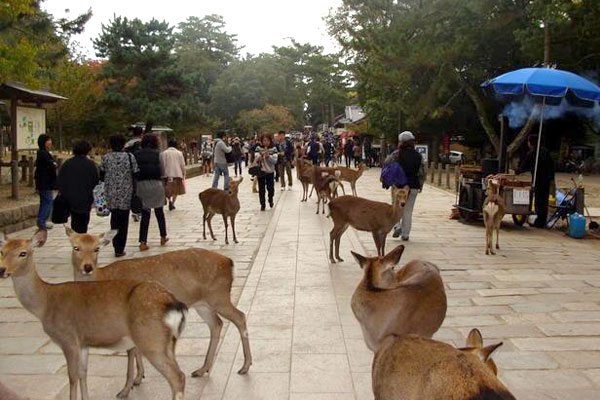
Deer in Japan’s Nara Prefecture are Messengers of the Gods
- By Krista R. Burdine --
- 22 Feb 2015 --

In Japan, deer roam free as the messengers of Shinto gods.
Visit the city of Nara, in the Nara Prefecture of Japan, and you will discover more than the location of the first permanent capital of the island nation. Roaming the streets with all the freedom and serenity of a ruling class, more than 1,000 wild Sika deer make themselves at home right alongside their human cohabitants. Although they primarily reside in the popular tourist attraction Nara Park or on the grounds of the area’s three Shintō shrines, the deer often venture into the city of 300,000 to visit. Sika deer are historically believed to be spiritual beings that commune with the gods who live in and around the Nara shrines.
Wealthy and educated Japanese elites brought Buddhism to Nara when it became the capital city in the 8th Century, and were instrumental to its growth and acceptance as a popular religion in Japan. Before Nara’s political rise to fame, however, the village was populated by indigenous Shintō farmers, who practiced nature and ancestor worship.
Further north in Japan, ritual dancing honors the Sika deer. Deer dancing, known as shishi-odori, happens at many festivals and events annually throughout Iwate Prefecture. Explanations variously attribute the origins of shishi-odori to imitating the movement of a deer, to mourning the death of a deer, or channeling the deer spiritual power to ward off evil.
The passage and existence of the Sika deer is carefully protected by religious interests as well as by the state, which regards them as a national treasure. Besides Nara, the deer are also protected on Miyajima Island in the south part of Japan. The presence of the deer extends back generations as they were considered to be messengers of the Shinto gods.
Nara, which recently marked the 1,300th anniversary of the beginning of its years as the nation’s capital, (710-784 AD, known historically as the Nara Period), remains the seat of government operations for its prefecture, or district. It still contains the ruins of several landmark Buddhist temples known together as the Nanto Shichi Daiji, whose influence lasted far beyond the area’s political prominence.


















